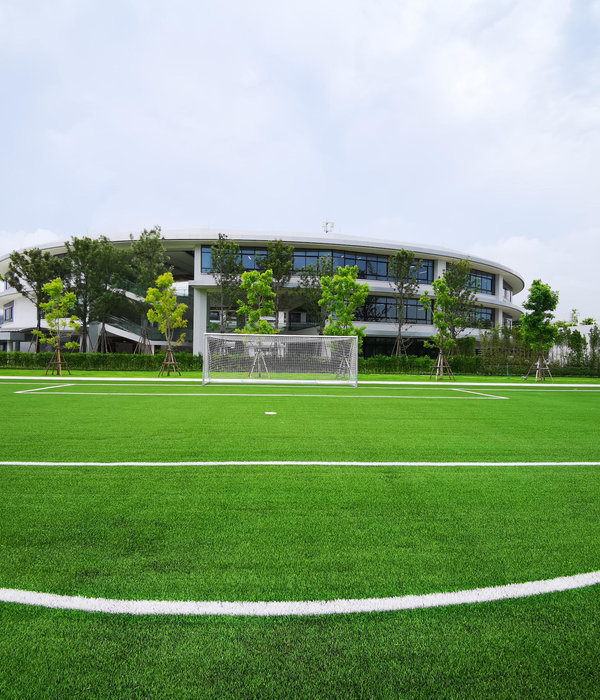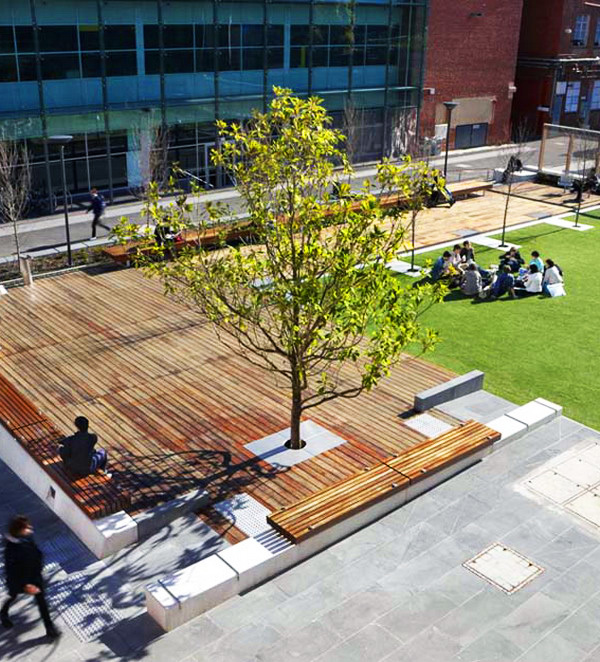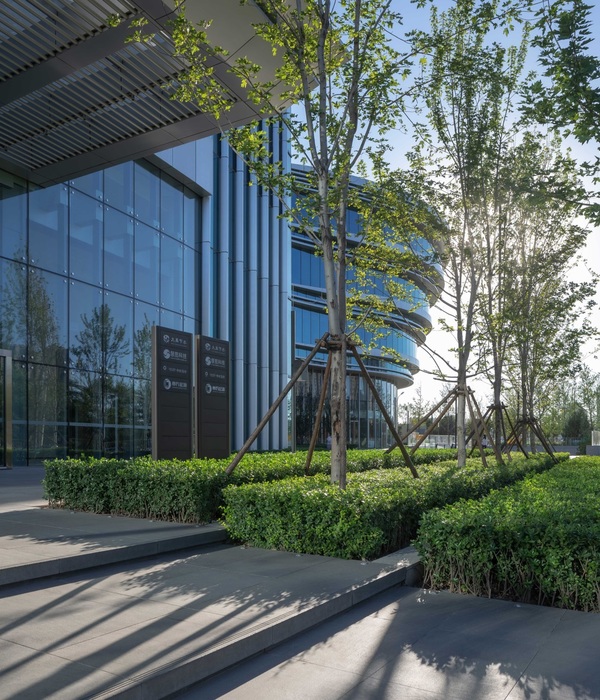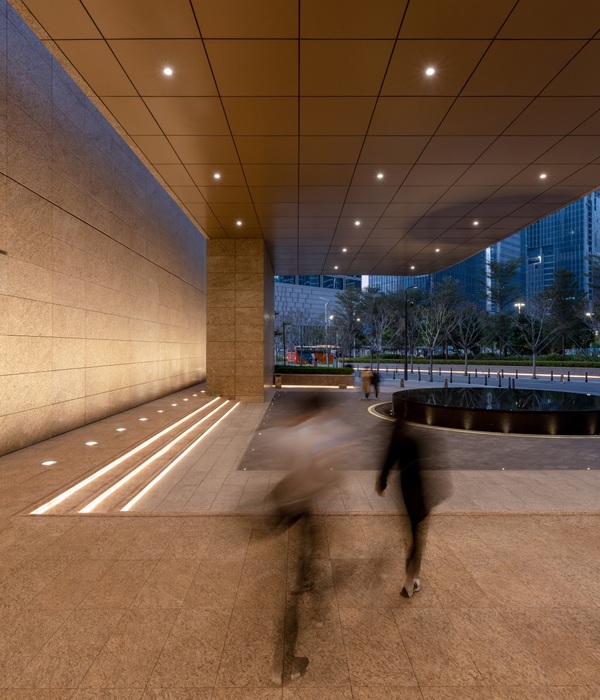Rotterdamsebaan公路具有欧洲最可持续的隧道设计,是现代基础设施的典范。该公路于上周六开放,连接了海牙环路和A4、A13两条高速路,其中1.8千米长的Victory Boogie Woogie隧道是欧洲最具可持续性发展的隧道。该项目的发起方是由BAM和Volker Wessels、Van Hattumen Blankevoort、KWS和Vialis几家公司组成的Combinatie Rotterdamsebaan,建筑事务所Benthem Crouwel Architects、Paul de Ruiter Architects和景观事务所Lanschappartners共同参与设计。
The design of the Rotterdamsebaan with the most sustainable tunnel in Europe, is an example for modern infrastructure. The Rotterdamsebaan opened last Saturday. This new road connects the ring road of The Hague with highways A4 and A13. Part of the Rotterdamsebaan is the 1.8-kilometer long Victory Boogie Woogie tunnel; the most sustainable tunnel in Europe. Benthem Crouwel Architects, Paul de Ruiter Architects and Lanschappartners jointly signed for the design commissioned by Combinatie Rotterdamsebaan, consisting of BAM and Volker Wessels, companies Van Hattumen Blankevoort, KWS and Vialis.
▼Victory Boogie Woogie隧道,Victory Boogie Woogie tunnel
嵌入绿化
EMBEDDED IN GREEN
在路途中融入景观是设计的核心。设计团队将部分道路置于地下,使现有的绿地得以保留,从而增设新的Molenvlietpark公园。公园内设有步行道和小型栈桥,引导行人经过芦苇荡、花草地和亲水河岸。服务站的倾斜形状融于景观,在公园一侧,植物爬满了建筑,使公园几乎看不到公路上的车流。步行路线、野餐场所和自然游乐区的植被种类繁多,构成了海牙城市景观和生物多样性的绿色资产。
The integration of the route into the landscape was central to the design of the Rotterdamsebaan. By having part of the route run underground, the existing green structure remained intact and a new piece of park could be added, the Molenvlietpark. The park is accessible by footpaths and small pedestrian bridges that lead you past reed land, flowery lawns and water features with nature-friendly banks. The sloping shape of the service building blends into the landscape and the vegetation overgrows the building at the park-side, which makes the traffic from the Rotterdamsebaan almost invisible from the park. The wide variety of vegetation with walking routes, picnic places and (nature) play areas is a green asset to the urban landscape of The Hague and its biodiversity.
▼公园内设有步行道和小型栈桥,the park is accessible by footpaths and small pedestrian bridges
上跨天桥
CROSS OVER
新建的人行天桥连接了公路两侧,形成了通往Drievliet家庭公园的新入口。天桥具有光滑的铝制外观,可以反射周围环境的颜色,其内部是暖色调且天然的,设有可持续的木甲板。桥身中间的护栏被抬高,降低了道路的噪音,营造出舒适而封闭的感觉。两侧接近绿地的护栏被降低,形成了面向周围景观的广阔视野。
The new pedestrian bridge that connects both sides of the Rotterdamsebaan forms a new entrance to the Drievliet family park. The bridge has a sleek, polished aluminum exterior which reflects the colors of the environment and a warm, natural interior with a sustainable wooden deck. In the center of the bridge, the balustrade is raised, which dampens the noise of the road and provides a comfortable, enclosed feel. When the bridge reaches the green landscape, the balustrade is lowered to provide a wide view over the surrounding greenery.
▼天桥中间高,两边低,the bridge is high in the middle and low on both sides
▼光滑的铝制外观,sleek aluminum exterior
▼可持续的木甲板,sustainable wooden deck
流线型路径
STREAMLINED ROUTE
在设计中,事务所Benthem Crouwel Architects和Paul de Ruiter Architects一致认为车行路和人行路应该在形式和材料上形成明显的对比,使司机体验到独特而连贯的明确路线。在上方人行路,独特的翼型金属挡板确定了的边界。在下方车行路,LED指示灯经过白色曲面墙的反射,衬托出流畅而沉稳的路径。
In the design, Benthem Crouwel Architects and Paul de Ruiter Architects have brought together the perspective of the driver and the pedestrian in an exciting contrast between form and material. Drivers will experience the Rotterdamsebaan as a clear route with a unique and consistent design. Above ground, the route is defined by its characteristic railing of wing-shaped lamellae. The underground route feels streamlined and calm with the guiding line of LED lights that are reflected by the white curved walls.
▼车行路和人行路的形式和材料形成明显的对比,the driver and the pedestrian in an exciting contrast between form and material
经久耐用的设计
A DURABLE DESIGN
The Rotterdamsebaan is a prime example of sustainable infrastructure in the Netherlands. Throughout the whole design process, the architects made choices to maximize the sustainability of the project and minimize the nuisance for the environment. For example, special concrete gutters at the side of the road absorb the noise and direct it upwards instead of sideways, and in the Victory Boogie Woogie tunnel, the fine dust from the cars is filtered at the tunnel entrances, resulting in approximately 50 percent less fine dust emission. The service building runs entirely on self-generated energy from the solar cells on the sloping roof of the building, and these solar cells also function as a light filter that prevents drivers from being dazzled by sunlight when they enter or exit the tunnel.
▼隧道入口,太阳能电池位于倾斜的屋顶上,entrance of the tunnel with solar cells on the sloping roof
隧道名称
VICTORY BOOGIE WOOGIE
隧道醒目的名称来自彼埃·蒙德里安的画作《百老汇爵士乐》(Victory Boogie Woogie),现收藏于海牙艺术博物馆。服务站指示板上的文字由Het Lab设计,设计师借鉴了蒙德里安的画作,设计出与其理念相符的字体,并用反光箔处理,提升了隧道的活力。
The striking name of the tunnel refers to the painting; Victory Boogie Woogie by Piet Mondrian that is part of the collection of Kunstmuseum Den Haag. The lettering on the fragmented lamellae of the service building is designed by Het Lab who designed the font in line with the concept of the painting and executed it in reflective foil, adding to the dynamic of the tunnel.
▼服务站,service building
▼隧道内部,interior of the tunnel
LOCATION: The Hague, The Netherlands
CLIENT: Combination Rotterdamsebaan, consisting of BAM and VolkerWessels, companies Van Hattum en Blankevoort, KWS and Vialis.
DESIGN ARCHITECTURE: Benthem Crouwel Architects & Paul de Ruiter Architects
LANDSCAPE DESIGN: Landschappartners
DESIGN LETTERING: Het Lab
COMPLETION: February 2021
PHOTOGRAPHY: Ossip van Duivenbode
{{item.text_origin}}












